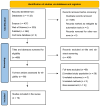Pregnancy and Neonatal Outcomes in Maturity-Onset Diabetes of the Young: A Systematic Review
- PMID: 40649834
- PMCID: PMC12250487
- DOI: 10.3390/ijms26136057
Pregnancy and Neonatal Outcomes in Maturity-Onset Diabetes of the Young: A Systematic Review
Abstract
Maturity-onset diabetes of the young (MODY)-a monogenic form of diabetes-accounts for approximately 1-2% of all diabetes cases, with GCK-MODY being the second most commonly diagnosed type. Although the inherited nature of the disease implies that the interplay between maternal glycemia and fetal genotype directly influences neonatal outcomes, clinical guidelines for MODY-complicated pregnancies remain underdeveloped. A systematic literature search in the PubMed, Scopus, Web of Science, and Cochrane databases was conducted following the PRISMA guidelines. The study protocol has been logged in the PROSPERO registry with the identification number CRD42024609390. Data, such as MODY type, the gestational age at delivery, mode of delivery, insulin administration, mutational status of the fetus, fetal birthweight (FBW), occurrence of small-/large-for-gestational age fetus, shoulder dystocia, and neonatal hypoglycemia, were extracted and evaluated. Among 19 studies selected for the final analysis, 15 investigated perinatal outcomes in the GCK-MODY variant. Women diagnosed with GCK-MODY treated with insulin delivered approximately 1-2 weeks earlier than those managed with diet alone. FBW was significantly higher in GCK-negative as compared to GCK-positive offspring. Accordingly, fetal macrosomia was notably more common among unaffected neonates. In GCK-affected fetuses, insulin therapy was associated with a significantly lower FBW. Fetal genotype critically modifies perinatal outcomes in GCK-MODY pregnancies. In the absence of fetal genotyping, conservative management should be prioritized to mitigate the risks of fetal growth restriction and iatrogenic prematurity. As data regarding other types of MODY in pregnancy remain sparse, there is an urgent need for more research in this area.
Keywords: GCK-MODY; HNF1A-MODY; HNF1B-MODY; MODY; diabetes in pregnancy; maturity-onset-diabetes of the young; monogenic diabetes; pregnancy.
Conflict of interest statement
The authors declare no conflicts of interest.
Figures
Similar articles
-
Maternal and neonatal outcomes of elective induction of labor.Evid Rep Technol Assess (Full Rep). 2009 Mar;(176):1-257. Evid Rep Technol Assess (Full Rep). 2009. PMID: 19408970 Free PMC article.
-
Different insulin types and regimens for pregnant women with pre-existing diabetes.Cochrane Database Syst Rev. 2017 Feb 3;2(2):CD011880. doi: 10.1002/14651858.CD011880.pub2. Cochrane Database Syst Rev. 2017. PMID: 28156005 Free PMC article.
-
Continuous subcutaneous insulin infusion versus multiple daily injections of insulin for pregnant women with diabetes.Cochrane Database Syst Rev. 2016 Jun 7;2016(6):CD005542. doi: 10.1002/14651858.CD005542.pub3. Cochrane Database Syst Rev. 2016. PMID: 27272351 Free PMC article.
-
Gestational weight gain below instead of within the guidelines per class of maternal obesity: a systematic review and meta-analysis of obstetrical and neonatal outcomes.Am J Obstet Gynecol MFM. 2022 Sep;4(5):100682. doi: 10.1016/j.ajogmf.2022.100682. Epub 2022 Jun 18. Am J Obstet Gynecol MFM. 2022. PMID: 35728780
-
Planned birth at or near term for improving health outcomes for pregnant women with gestational diabetes and their infants.Cochrane Database Syst Rev. 2018 Jan 5;1(1):CD012910. doi: 10.1002/14651858.CD012910. Cochrane Database Syst Rev. 2018. PMID: 29303230 Free PMC article.
References
-
- Aarthy R., Aston-Mourney K., Mikocka-Walus A., Radha V., Amutha A., Anjana R.M., Unnikrishnan R., Mohan V. Clinical Features, Complications and Treatment of Rarer Forms of Maturity-Onset Diabetes of the Young (MODY)—A Review. J. Diabetes Complicat. 2021;35:107640. doi: 10.1016/j.jdiacomp.2020.107640. - DOI - PubMed
Publication types
MeSH terms
Substances
Supplementary concepts
LinkOut - more resources
Full Text Sources
Medical
Research Materials
Miscellaneous


